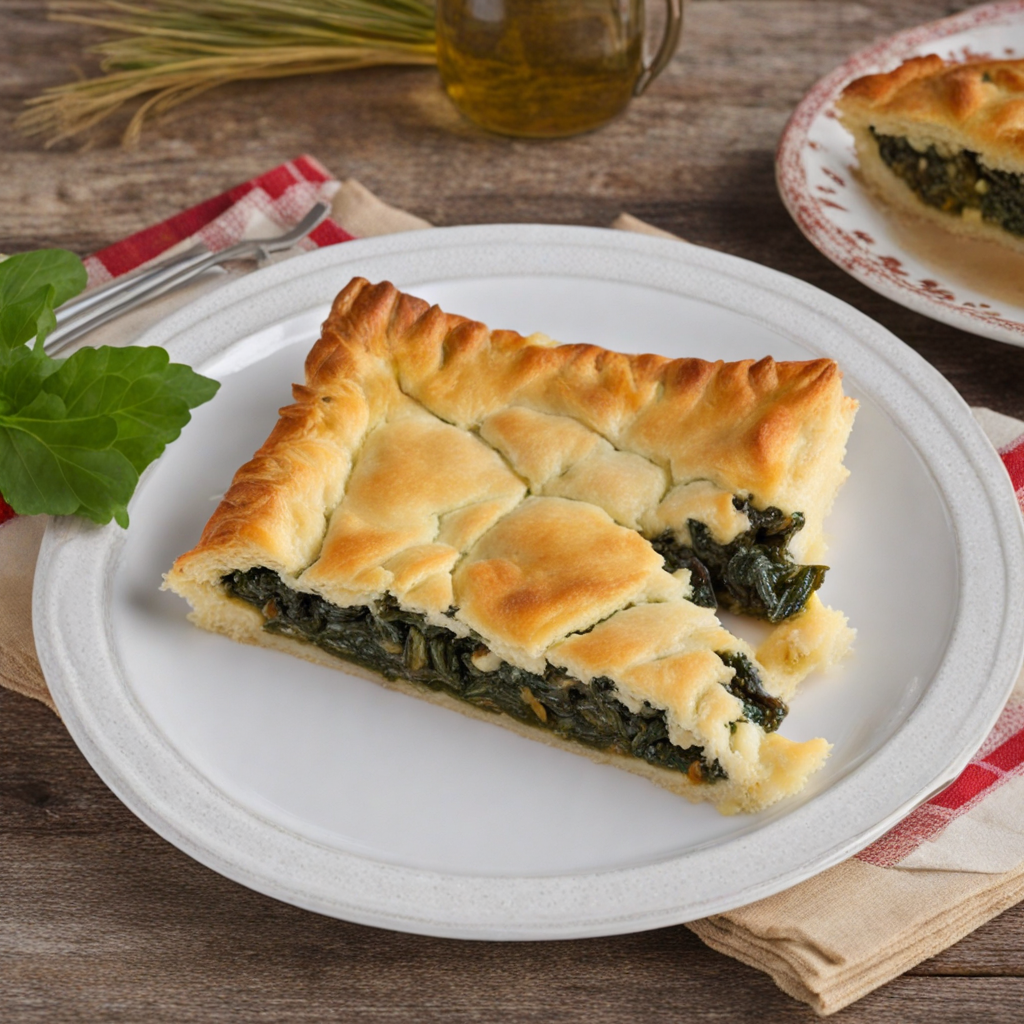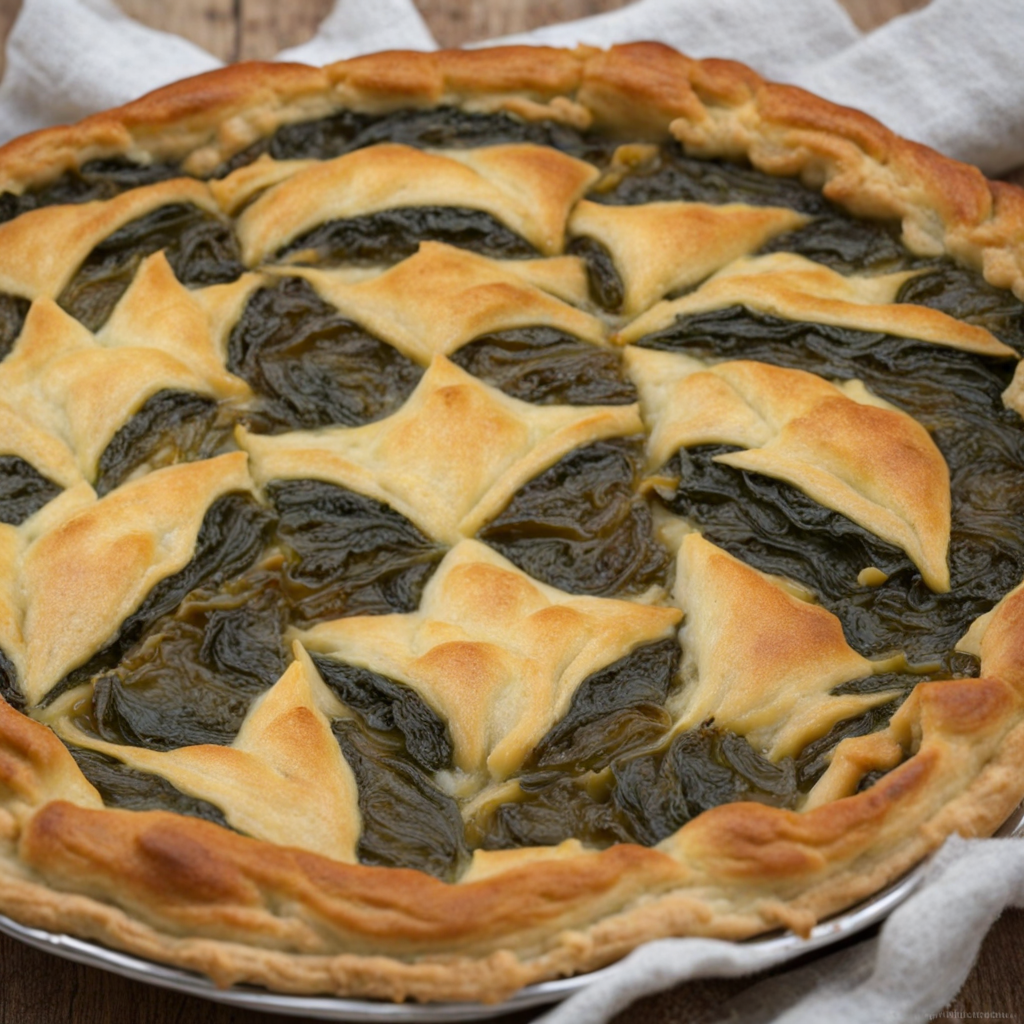Soparnik
Soparnik is a traditional Croatian dish that hails from the region of Dalmatia, particularly associated with the town of Poljica. This savory pie is made with a thin, flaky crust that encases a delicious filling of chard, onions, and herbs, often seasoned with olive oil and salt. The dough is typically prepared from flour and water, rolled out into two sheets, and carefully layered to create a delicate exterior that perfectly complements the vibrant greens inside. The simplicity of the ingredients highlights the freshness of the local produce, making Soparnik a beloved comfort food among Croatians and a delightful discovery for food enthusiasts. As you take your first bite of Soparnik, the crust crumbles ever so slightly, revealing the succulent filling that bursts with flavor. The chard, often mixed with aromatic garlic and perhaps a hint of parsley, provides a slightly earthy taste that is both satisfying and refreshing. The use of good-quality olive oil not only enhances the flavor but also adds a rich, buttery texture to the pie. Traditionally baked in a wood-fired oven, Soparnik develops a beautiful golden-brown crust that carries a subtle smokiness, making each piece a treat for the senses. Soparnik is often served warm, cut into squares, and can be enjoyed as a main dish or as a side. It pairs wonderfully with a dollop of yogurt or a simple side salad, making it a versatile option for any meal. This dish is not just about taste; it embodies the spirit of Croatian hospitality and the celebration of local ingredients, inviting you to experience the rustic charm of Dalmatian cuisine. Discovering Soparnik is like uncovering a hidden gem of the Mediterranean diet, where tradition and flavor come together in a delightful and memorable way.
How It Became This Dish
Soparnik: A Culinary Heritage of Croatia Soparnik is more than just a dish; it is a culinary testament to the rich history and cultural tapestry of Croatia, particularly the Dalmatian region. This traditional savory pie, filled with Swiss chard and onions, encased in a thin layer of dough, has become emblematic of the rural heritage of the village of Poljica, where it has been lovingly prepared for generations. The history of Soparnik is a fascinating journey that reflects the resilience of local communities, the influence of regional agriculture, and the importance of food in cultural identity. Origins The roots of Soparnik trace back to the 16th century in the Poljica region, an area known for its fertile soil and agricultural bounty. The dish is believed to have been created by the local population, particularly the women, who sought to make use of the abundant wild greens available in the area. Swiss chard, or "blitva" as it is known in Croatian, became the star ingredient, providing both sustenance and flavor. Other ingredients typically include onions, olive oil, and spices, all of which reflect the Mediterranean climate and agricultural practices of the region. Soparnik's preparation is a reflection of the humble, resourceful nature of rural life. It was often made as a meal for laborers working in the fields, as it was easy to transport and could be eaten cold or warm. The method of cooking Soparnik also speaks to the local traditions; it was traditionally baked in a wood-fired oven, which imparted a unique flavor to the dish. The choice of Swiss chard not only showcases the local produce but also highlights the agricultural practices that have been passed down through generations. Cultural Significance Over the centuries, Soparnik has evolved into a symbol of cultural pride for the Poljica region. It is more than just a meal; it embodies the communal spirit of the people. Traditionally, Soparnik was made for special occasions, family gatherings, and festivals. It served as a way to bring people together, fostering a sense of community and shared heritage. The preparation of Soparnik often involved families working together, passing down recipes, and sharing stories, reinforcing familial bonds and cultural continuity. In 2016, Soparnik was recognized by the Croatian Ministry of Culture as part of the intangible cultural heritage of Croatia, which highlights its significance in preserving local traditions. This designation has helped to raise awareness of Soparnik beyond its local origins, positioning it as an important aspect of Croatian cuisine on a national and international scale. Festivals celebrating Soparnik have emerged, where locals showcase their culinary skills and share the dish with visitors, further cementing its role as a cultural ambassador for the region. Moreover, Soparnik reflects the broader historical context of Croatia, marked by a series of migrations, conflicts, and cultural exchanges. The dish’s ingredients and preparation methods have been influenced by various cultures, including Italian and Ottoman, highlighting the melting pot of influences that have shaped Croatian cuisine. This intersection of cultures is evident in the use of olive oil, a staple in Mediterranean cooking, and the technique of baking in wood-fired ovens, common in many Mediterranean countries. Development Over Time As Croatian society has transformed, so too has the preparation and perception of Soparnik. In the past, it was primarily a rural dish, consumed mostly by the local populace. However, as urbanization has changed the landscape, Soparnik has begun to capture the imagination of chefs and food enthusiasts beyond its regional roots. Contemporary interpretations of Soparnik are emerging in restaurants, where chefs experiment with fillings and presentation while honoring traditional methods. The dish has also gained popularity in culinary events and competitions, showcasing its versatility and adaptability. Some chefs have introduced variations that include different greens, cheeses, or even meat, while maintaining the essence of the original recipe. These innovations reflect the evolving nature of food culture, where traditional dishes are reimagined to appeal to modern palates without losing their historical significance. In addition to its culinary evolution, Soparnik has also found a place in the realm of gastronomy as a symbol of local identity. As globalization continues to influence food trends, there has been a resurgence of interest in traditional and regional cuisines. Soparnik has emerged as a representative dish of Dalmatian cuisine, celebrated for its simplicity and wholesome ingredients. Social media and food blogs have played a significant role in this revival, allowing individuals to share their experiences and recipes, thus promoting the dish to a wider audience. Conclusion Soparnik is a dish that encapsulates the essence of Croatian culture, reflecting the agricultural practices, communal spirit, and resilience of the people of Poljica. Its journey from a humble rural meal to a celebrated symbol of cultural heritage exemplifies the power of food as a connector of people and traditions. As it continues to evolve in response to changing times and tastes, Soparnik remains a poignant reminder of the importance of preserving culinary heritage while embracing innovation. In a world where food often serves as a bridge to our past, Soparnik stands out as a delicious narrative of history, culture, and identity. Whether enjoyed in a traditional setting or a modern restaurant, this savory pie carries with it the stories of those who have come before, making each bite a taste of Croatia's rich culinary legacy.
You may like
Discover local flavors from Croatia







